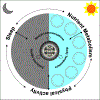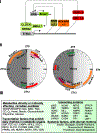Training the Circadian Clock, Clocking the Drugs, and Drugging the Clock to Prevent, Manage, and Treat Chronic Diseases - PubMed (original) (raw)
Review
Training the Circadian Clock, Clocking the Drugs, and Drugging the Clock to Prevent, Manage, and Treat Chronic Diseases
Gabriele Sulli et al. Trends Pharmacol Sci. 2018 Sep.
Abstract
Daily rhythms in behavior, physiology, and metabolism are an integral part of homeostasis. These rhythms emerge from interactions between endogenous circadian clocks and ambient light-dark cycles, sleep-activity cycles, and eating-fasting cycles. Nearly the entire primate genome shows daily rhythms in expression in tissue- and locus-specific manners. These molecular rhythms modulate several key aspects of cellular and tissue function with profound implications in public health, disease prevention, and disease management. In modern societies light at night disrupts circadian rhythms, leading to further disruption of sleep-activity and eating-fasting cycles. While acute circadian disruption may cause transient discomfort or exacerbate chronic diseases, chronic circadian disruption can enhance risks for numerous diseases. The molecular understanding of circadian rhythms is opening new therapeutic frontiers placing the circadian clock in a central role. Here, we review recent advancements on how to enhance our circadian clock through behavioral interventions, timing of drug administration, and pharmacological targeting of circadian clock components that are already providing new preventive and therapeutic strategies for several diseases, including metabolic syndrome and cancer.
Keywords: Rev-erb; chronotherapy; circadian clock; circadian rhythm disruption; shift work; time-restricted eating.
Copyright © 2018 Elsevier Ltd. All rights reserved.
Conflict of interest statement
Conflict of interest: S.P. is the author of the book titled “The Circadian Code” for which he receives author’s royalties. The grant funders nor the publisher of the book had any influence on the content of this article
Figures
Figure 1.. Circadian rhythms emerge from multiple factors including the circadian clock.
Schematic organization of various factors that interact to produce daily rhythms in behavior, physiology and metabolism. Network of cell autonomous circadian oscillators in the suprachiasmatic nucleus (SCN) directly or indirectly communicates with peripheral circadian clocks through neural communications, endocrine agents and body temperature rhythms. Both SCN and peripheral clocks interact to produce daily rhythms in sleep, physical activity, and nutrition metabolism, each of which can also feedback to central or peripheral clocks. Overall, both SCN and the peripheral circadian oscillators are influenced by ambient light-dark cycle.
Figure 2.. Hallmarks of circadian regulation.
A. The genetic code denotes the set of protein coding genes in the genome. The epigenetic code instructs the expression of a subset of genes in the genome to be expressed in a given tissue that determines the tissue identity and function. Similarly, the circadian code instructs a subset of transcripts in every given tissue to be temporally regulated. The ensemble of rhythmic transcripts in different tissues determine the diurnal rhythms in physiology, metabolism and behavior. B. Functional annotation of rhythmic transcripts has revealed some of the basic cellular processes are circadianly modulated in multiple tissues. Some of these processes are depicted below.
Figure 3.. Circadian rhythm disruption and diseases across lifespan.
CRD can manifest in different diseases and disorders during the lifespan of an individual. In early childhood, disruption of the rhythm can cause irritability, mood swings and fatigue that can lead to impaired growth and development in extreme cases. As we age, chronic circadian rhythm disruption continuing over several weeks or months can cause mild disorders like fragmented sleep and compromised learning to an increased risk for a number of chronic diseases, including Type2 diabetes, Alzheimer’s etc. While milder forms of the diseases can be alleviated by behavioral adjustments to improve circadian rhythms, optimal timing of existing drugs or even pharmacological targeting of circadian clock components hold promise for treating some of the severe chronic diseases.
Text Box Figure 1
Similar articles
- Chronopharmacological strategies focused on chrono-drug discovery.
Ohdo S, Koyanagi S, Matsunaga N. Ohdo S, et al. Pharmacol Ther. 2019 Oct;202:72-90. doi: 10.1016/j.pharmthera.2019.05.018. Epub 2019 Jun 5. Pharmacol Ther. 2019. PMID: 31173839 Review. - Chronotherapeutic strategy: Rhythm monitoring, manipulation and disruption.
Ohdo S. Ohdo S. Adv Drug Deliv Rev. 2010 Jul 31;62(9-10):859-75. doi: 10.1016/j.addr.2010.01.006. Epub 2010 Feb 25. Adv Drug Deliv Rev. 2010. PMID: 20188774 Review. - Circadian Rhythms, Disease and Chronotherapy.
Lee Y, Field JM, Sehgal A. Lee Y, et al. J Biol Rhythms. 2021 Dec;36(6):503-531. doi: 10.1177/07487304211044301. Epub 2021 Sep 22. J Biol Rhythms. 2021. PMID: 34547953 Free PMC article. Review. - Circadian rhythms: influence on physiology, pharmacology, and therapeutic interventions.
Ayyar VS, Sukumaran S. Ayyar VS, et al. J Pharmacokinet Pharmacodyn. 2021 Jun;48(3):321-338. doi: 10.1007/s10928-021-09751-2. Epub 2021 Apr 1. J Pharmacokinet Pharmacodyn. 2021. PMID: 33797011 Free PMC article. Review. - Therapeutics on the clock: Circadian medicine in the treatment of chronic inflammatory diseases.
Jacob H, Curtis AM, Kearney CJ. Jacob H, et al. Biochem Pharmacol. 2020 Dec;182:114254. doi: 10.1016/j.bcp.2020.114254. Epub 2020 Oct 1. Biochem Pharmacol. 2020. PMID: 33010213 Review.
Cited by
- Circadian Effects of Drug Responses.
Nahmias Y, Androulakis IP. Nahmias Y, et al. Annu Rev Biomed Eng. 2021 Jul 13;23:203-224. doi: 10.1146/annurev-bioeng-082120-034725. Epub 2021 Mar 31. Annu Rev Biomed Eng. 2021. PMID: 33788580 Free PMC article. - Evaluation of small-molecule modulators of the circadian clock: promising therapeutic approach to cancer.
Tavsanli N, Erözden AA, Çalışkan M. Tavsanli N, et al. Mol Biol Rep. 2024 Jul 24;51(1):848. doi: 10.1007/s11033-024-09813-x. Mol Biol Rep. 2024. PMID: 39046562 Review. - Dark-light cycle disrupts bone metabolism and suppresses joint deterioration in osteoarthritic rats.
Song X, Zhao M, Tang J, Ma T, Bai H, Wang X, Liu L, Li T, Xu X, Sheng X, Zhao B, Wang Y, Wang T, Guo Y, Zhang X, Gao L. Song X, et al. Arthritis Res Ther. 2022 Jun 28;24(1):158. doi: 10.1186/s13075-022-02832-8. Arthritis Res Ther. 2022. PMID: 35765090 Free PMC article. - Circadian rhythms: a regulator of gastrointestinal health and dysfunction.
Voigt RM, Forsyth CB, Keshavarzian A. Voigt RM, et al. Expert Rev Gastroenterol Hepatol. 2019 May;13(5):411-424. doi: 10.1080/17474124.2019.1595588. Epub 2019 Mar 25. Expert Rev Gastroenterol Hepatol. 2019. PMID: 30874451 Free PMC article. Review. - Circadian clock regulator Bmal1 gates axon regeneration via Tet3 epigenetics in mouse sensory neurons.
Halawani D, Wang Y, Ramakrishnan A, Estill M, He X, Shen L, Friedel RH, Zou H. Halawani D, et al. Nat Commun. 2023 Aug 24;14(1):5165. doi: 10.1038/s41467-023-40816-7. Nat Commun. 2023. PMID: 37620297 Free PMC article.
References
- Mairan J.-J.d. (1729) Observation botanique. Histoire de l’Academie Royale des Sciences. 35–36.
Publication types
MeSH terms
LinkOut - more resources
Full Text Sources
Other Literature Sources
Medical



